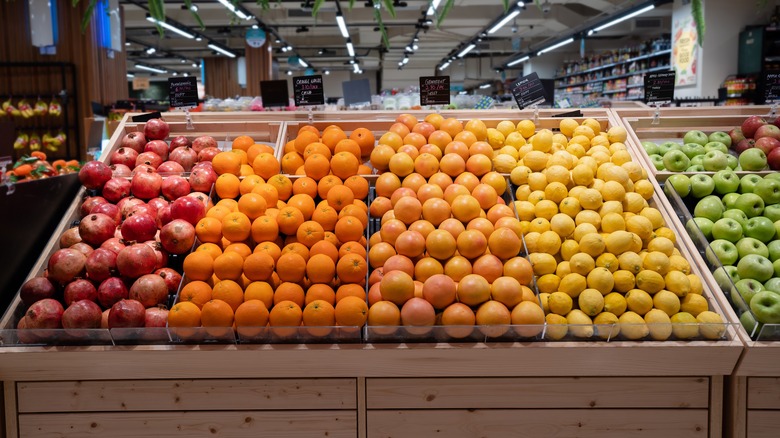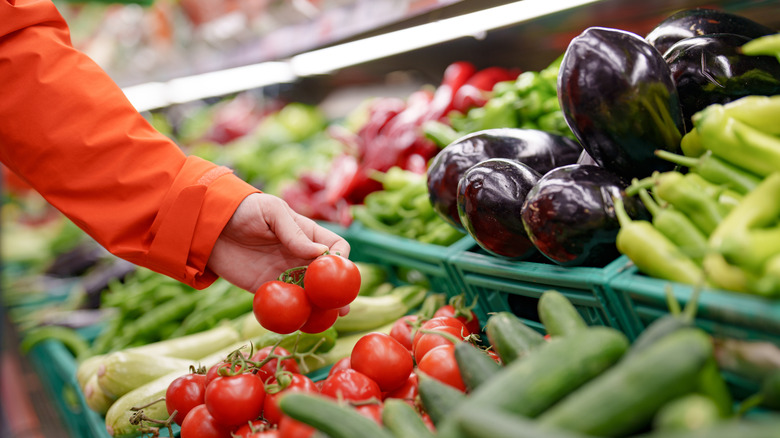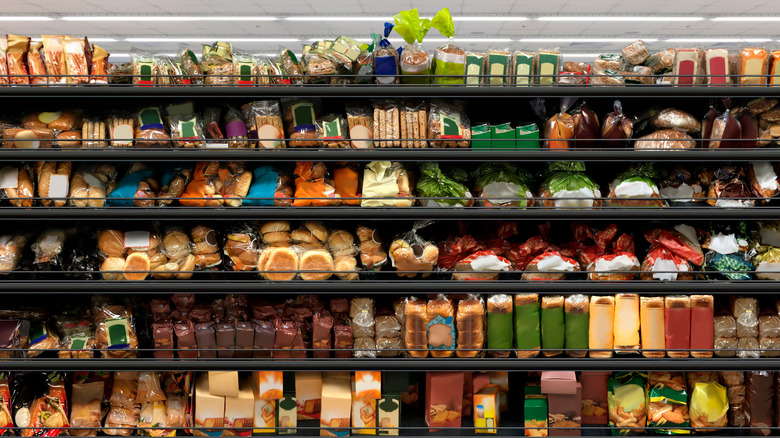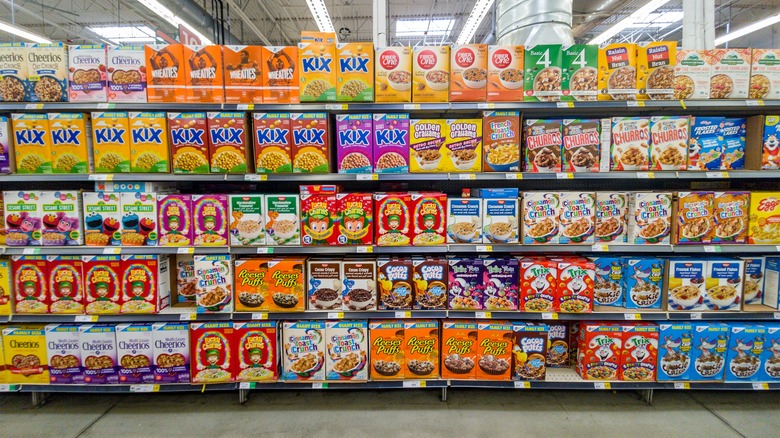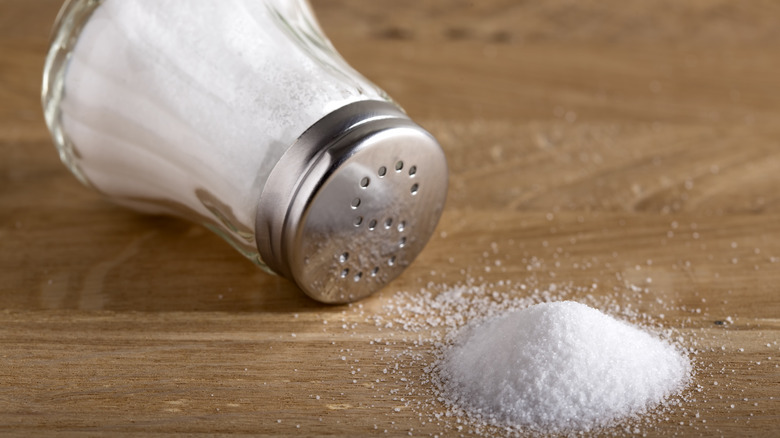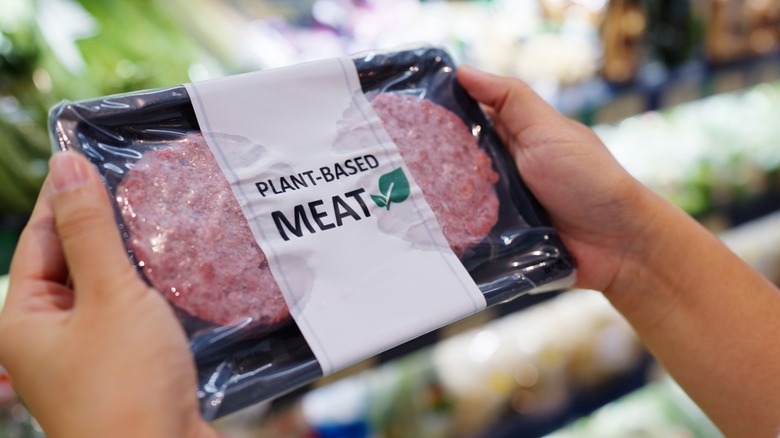Common Grocery Store Food Labels That Are A Huge Red Flag
With a seemingly endless variety of products on the shelves, grocery stores can be a difficult place to maneuver if you want to find healthy options. For those with food sensitivities or preferences, it can be very tricky to figure out what foods will work and which ones to avoid. Reading the foods' labels is a great way to learn more about the ingredients and nutritional profile of the snack or meal, but even these labels can be misleading at times.
Many food labels include more marketing jargon than actual information. Without an understanding of what these things mean, consumers can be influenced to buy a product that doesn't meet their needs. Certain red flags you might see on a food's label don't always mean that the food is unhealthy or tastes bad. But it's worth taking a closer look when you see one of these things on the label, since there might be other factors that will impact your buying choice.
Gluten-free labels on fruits and vegetables
Some products feature gluten-free labeling to appeal to customers with celiac disease or gluten sensitivities or those looking to avoid gluten for other reasons. This can be helpful because it provides reassurance that this product is free of ingredients that could make someone sick and works with a gluten-free diet. But if the food in question doesn't contain gluten in the first place, such as fruits and vegetables, adding the gluten-free label doesn't mean anything. This misleading label can confuse customers and influence them to needlessly choose certain brands.
According to the Food and Drug Administration's rules, a product must have less than 20 parts per million, or ppm, of gluten to include the gluten-free label. Fruits and veggies do not contain any gluten naturally, so they meet this requirement by default. If you see fruits and vegetables labeled as gluten-free and being sold for a higher price than the same option without the label, consider if there's something else making the product worth the expense. An apple with a gluten-free label is the same as one without the label and typically isn't worth more.
Lunch meat with added water
Some water is present in all meat, and the amount can vary based on the type, cut, and even the diet that the animal was given. But added water is another story. Ham, turkey, and other meats can have added water to make them more tender and change their taste. The U.S. Department of Agriculture requires that meats injected, soaked, or otherwise altered with water or flavorings be labeled with the ingredients and solution. These are considered enhanced meats. This means that they are more processed, and in many cases, they can be more expensive because you pay for the weight of the package, water and all.
If water is the second ingredient behind meat on the ingredients list, it's likely very processed. You might be getting less actual meat than you would expect because you are paying for extra water or flavoring. Some lunch meats have more flavor or last longer thanks to the injected solution, but if you want more meat for your money or just prefer something less processed, look for lunch meat with the no retained water label. While these meats include naturally occurring water that is the result of the product's processing, they haven't been injected with brine or water-based flavoring solutions.
No sugar added to fruits and vegetables
This is another label that sounds good but doesn't carry much meaning in certain foods. Raw fruits and vegetables don't have any added sugar — all produce could include the no sugar added label because they don't have anything at all added, sugar or otherwise. Whether they are labeled no sugar added or not is irrelevant and doesn't change their nutritional value or content. Such labeling can make consumers think that a particular fruit, vegetable, or brand is superior to others when it's actually identical.
It's also important to know that you are still consuming sugar when you eat produce. Just because a product doesn't have sugar added doesn't mean it isn't high in sugar. Fruits and vegetables contain natural sugars, so don't be fooled into thinking that no additional sugar means sugar-free. While fresh fruits and vegetables are part of a balanced diet for most people, those with specific dietary needs or those who need to limit sugar intake of all types should be aware of the sugars in fruits and veggies.
No expiration date on olive oil
Oils should have clearly marked expiration dates. The USDA recommends keeping unopened cooking oils for around four months, though other sources claim they taste fine for up to two years after bottling. Either way, once you open the oil, the shelf life becomes shorter. Over time, the light and oxygen from the environment can change the chemical composition of olive oil and cause it to become rancid. While rancid, spoiled olive oil isn't a rich breeding ground for bacteria that could make you sick, it doesn't taste good. Many chefs use olive oil while cooking, and the last thing that you want is for a spoonful of bad olive oil to make your entire dish taste sour or bitter.
With all this in mind, it's important that your olive oil has a clearly labeled best-by date and that you follow it. This information is often placed on the back or top of the bottle. Some small-batch olive oils will include a bottling date instead of a best-by date. Some growers recommend looking for a harvest date as well. These labels allow you to trace the olive from the tree to the bottle and ensure that you know when to use the oil by for the best taste.
Light yogurt
When buying yogurt, you might want to seek out products that meet certain nutritional criteria, such as extra protein or less fat. But, it can be hard to accurately compare labels on yogurt containers across all brands. The light label on yogurt can be misleading because it doesn't provide any health information about the product relative to other, similar types of yogurt in the dairy case. It just means that the yogurt has less fat or calories than the regular version of that product from the same company. Brands are only required to differentiate between how their own products were processed and not between their light yogurt and offerings from other brands.
Even though a yogurt is labeled as light, it could still be loaded with chemicals, preservatives, and extra sugar compared to other brands. It's best to look at the nutrition facts on the back to compare these things. You may also see a yogurt labeled as "lite," which is the same marketing with a different spelling. In either case, look closer at the nutrition label and ingredients list for the most helpful information.
You can also seek out yogurt labeled as low-fat or non-fat. These labels actually do provide information about the fat content that can be used to compare them to other brands. Per FDA rules, low-fat yogurt needs to be between 0.5% and 2% fat, while non-fat yogurt can't have more than 0.5% fat.
No high fructose corn syrup in candy
Consumers have become wary of high fructose corn syrup due to its high sugar content. It is added to many processed foods, including candy, because it is a cheap sweetener. High fructose corn syrup is simply a combination of glucose and fructose with a higher concentration of fructose relative to regular corn syrup. Our bodies don't process fructose in the same way as glucose, and it is often stored as fat. The Food and Drug Administration, however, does not recognize any adverse health effects of high fructose corn syrup specifically, relative to any other sugars. Most importantly, even though candy labeled as being free of high fructose corn syrup may sound like it has less sugar, it almost always has another type of sugar to replace the HFCS.
Candy uses sugar for taste, texture, and consistency. Other sweeteners, such as honey, fruit juice, and table sugar, have a similar chemical composition to high fructose corn syrup. Honey contains a combination of fructose and glucose, just like HFCS. Fruit juice is made of fructose, while table sugar is made of sucrose, a combination of fructose and glucose. When looking at sugars, it's important to remember that candy without HFCS can still include sugar. For those trying to limit their sugar intake, it's not enough to rely on the no HFCS label to make decisions when it comes to sweet treats like candy.
Low-fiber bread
Grains contain fiber, so any bread or grain-based products that promise low fiber are highly processed. While some people may need a low-fiber option, for most, it's best to explore alternatives with fewer additives. Because bread is a high-fiber food, the products with a significantly lower amount of fiber often have other ingredients that can have adverse health effects, such as high amounts of sugar. White bread has the lowest amount of fiber because it's made with refined grains.
Whole grains have a number of health benefits, and low-fiber breads have few. So even though the word "low" may be associated with foods that cater to specific dietary needs, in most cases a low-fiber option doesn't work as well as full-fiber products for digestive health. The exception to this is those with digestive issues who require less strain on their system. Even in these cases, though, a low-fiber diet is typically only recommended for short periods of time.
All-natural deli meat
Although it sounds good, this label has very little actual meaning and is not regulated. Just about any product can claim to be all-natural and still contain plenty of artificial or processed ingredients. While the FDA has received petitions for official definition of the term "natural," right now, it doesn't have any specific requirements. It has, however, become standard practice to use the terms "natural" or "all-natural" to mean that the product does not contain any artificial or synthetic ingredients, including coloring and flavoring agents.
Almost all deli meat is processed in some way, so the all-natural claim is just a marketing gimmick and doesn't mean that the meat is in its natural state. Deli meat is often ground and pressed into shape before being sliced, but the FDA specifically states that the term "natural" does not have any relation to the processing or manufacturing steps used to make the meat. Even highly processed deli meat can still be labeled as all-natural because it doesn't include any artificial ingredients or additives.
All-natural eggs
There are plenty of labels to decipher on eggs, but all eggs are all-natural because they are a whole food. If you see eggs labeled as all-natural, it doesn't mean that the eggs are any different from their counterparts without the label. As mentioned, the FDA does not regulate the terms "natural" or "all-natural." Unless there actually are added synthetic ingredients, eggs can be labeled all-natural.
An all-natural label on eggs can be misleading when they cost more or are presented as healthier than other options. Eggs are single-ingredient items, so both eggs labeled as all-natural and those without the label are exactly the same — either way, they're eggs. What can vary is the diet or living conditions of the chickens that laid the eggs. In these cases, labels like cage-free and free-range, as well as organic, can be much more helpful to make an informed choice between eggs and brands.
Natural flavors in processed snack food
When you see natural flavors included in a food's ingredients list, be aware that natural flavors are not always ingredients that we see in nature. Again, the terms "all-natural" and "natural" have little regulation from the FDA. All they mean is that the product doesn't have artificial additives. Extra ingredients like sugar and some colorings and flavorings can still be counted as natural, even though they are added to the recipe in quantities that would not happen in a natural, whole food. Natural flavorings can include spices, spice extracts, essential oils, and similar ingredients meant to boost or add flavor.
All-natural snack foods can still be processed to the point of unrecognizability, reducing overall health benefits and adding ingredients that you might not expect. For example, gummy fruit snacks are typically made with sweetened fruit juices and extracts and not actual fruit. Even though the packaging may boast claims of being made with fruit or fruit juice, the first two ingredients on the back might be corn syrup and sugar. Don't let the natural flavors label trick you into thinking that a highly processed snack food is close to a natural, whole food.
Flavored cereals
Flavored coffees, yogurts, cereals, and other products almost always contain extra sugar and chemical flavoring agents other than the actual fruit or spice the flavor is named for. Cereals with fruit pictured on the packaging likely still have sugar among the top five ingredients. Fruit, meanwhile, is typically pretty far down on the ingredients list, if it's even there at all. Companies can use artificial coloring, as well, to make it appear like fruit is part of the recipe.
Even in cereals with fruit added, said fruit is dehydrated for shelf stability, and the actual amount of fruit present can still be much less than expected. In most cases, fruit flavorings or purees are as close as you get to actual fruit in the product. It's important to rely on the cereal's ingredients list and nutrition facts to make buying decisions rather than the label or picture on the front of the box.
Low-sodium salt
Salt is the common name for sodium chloride, so all salts contain sodium. While you won't see no-sodium salt, you might come across seasonings labeled as low-sodium salts or "lite" salt. These can add flavor, but because they are low in sodium, "salt" might be a misleading label. It's likely pretty far down on the ingredients list. Low-sodium salts can be a blend of salt and other flavorings or replace some of the salt with a similar-tasting substitute.
If you see a salt that is listed as low in sodium, take a closer look at the ingredients list to see what is actually in it. Potassium chloride is a common substitute for salt and is added to "lite" or low-sodium salts. While this might work for those on a low-sodium diet, it's important to know exactly what you are eating. Individuals with kidney or heart issues might need to follow a doctor's recommendation for a low-potassium diet, and in such cases, a low-sodium salt can actually do more harm than good.
No cholesterol on plant-based products
Cholesterol only occurs in animal products. Drawing attention to a plant-based product for its lack of cholesterol can make it appear to be a more health-conscious choice than it actually is. Plant-based meat substitutes often advertise having no cholesterol on their packaging to point out how that product is different than meat to appeal to consumers trying to limit their cholesterol intake. What that statement doesn't include is the list of additives that are used to make that product taste and feel like meat when you eat it. For example, potassium lactate might pose a hazard to those avoiding potassium.
There's more than one type of cholesterol, and not all of them are bad. Low-density lipoprotein, or LDL cholesterol, can build up in your arteries and cause problems. On the other hand, high-density lipoprotein, or HDL cholesterol, helps carry LDL cholesterol to your liver to process out of your body, so some HDL cholesterol is a good thing. A "no cholesterol" label does not provide information about how dietary cholesterol is processed in your body. High amounts of saturated fat in one's diet have been shown to increase LDL cholesterol levels, and plant-based meat often still contains some, even if it's less than regular meat. So if you are trying to lower your cholesterol, choosing a plant-based product simply because it is labeled "no cholesterol" might not have the effect that you want.
No date on bread
Bread, like all foods, is not required by the FDA to include an expiration date, but it's preferable if it has some kind of date printed on the bag or container. Pay close attention to whether this is a sell-by date or a best-by date. While omitting this date doesn't change the quality of the bread inside, it can be a red flag for freshness. If you can't tell when the bread was made, there's no way to know if it is one day old or more. And who wants to pay full price for bread that is about to go stale?
A best-by date isn't legally required, either, but does indicate when the bread will be the best quality. Bread can start to develop mold within a few days, especially if it is stored somewhere moist where the mold spores can grow. While the best-by date doesn't indicate a timeline to consume the food safely, the longer the bread is out, the more likely it is to grow mold. Storing sliced bread in a cool, dry environment for a few days works to keep it fresh and reduce the potential for mold. If you need to store it for more than a few days, the freezer is a great place to keep mold from growing without drying out the bread.

